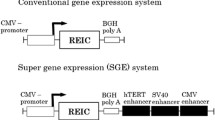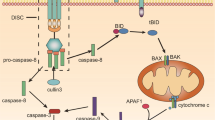Abstract
Background: Tumor necrosis factor–related apoptosis-inducing ligand (TRAIL) induces apoptosis in malignant cells but not in normal cells. Ad/g-TRAIL, an adenoviral vector in which expression of green fluorescent protein (GFP) and TRAIL is driven by a human telomerase reverse transcriptase promoter, has shown promise as a targeted antitumor agent.
Methods: To investigate the effects of TRAIL gene therapy on pancreatic cancer, BxPC-3, MIA-PaCa-2, Panc-1, and ASPC-1 cells were treated with Ad/g-TRAIL. Transfection and protein expression were determined by using immunoblotting and identification of GFP with fluorescent microscopy and flow cytometry. Cell viability was determined by proliferation assay. Cell-cycle analysis and quantification of caspase-3 were used to identify apoptosis. The in vivo efficacy of Ad/g-TRAIL was characterized in a novel red fluorescent protein murine model of MIA-PaCa-2 pancreatic cancer.
Results: Cells treated with Ad/g-TRAIL expressed GFP and exhibited apoptotic morphology within 2 days of treatment. Treatment with this vector in vitro resulted in less cell viability, increased caspase-3 activity, and a greater apoptotic fraction than treatment with controls. In vivo, treatment with Ad/g-TRAIL significantly suppressed tumor growth.
Conclusions: TRAIL gene therapy induces apoptosis of pancreatic tumor cells both in vitro and in vivo and is a promising therapy in the treatment of pancreatic cancer.
Similar content being viewed by others
REFERENCES
Jemal A, Thomas A, Murray T, Thun M. Cancer statistics, 2002. CA Cancer J Clin 2002; 52: 23–47.
Sener SF, Fremgen A, Menck HR, Winchester DP. Pancreatic cancer: a report of treatment and survival trends for 100,313 patients diagnosed from 1985–1995, using the National Cancer Database. J Am Coll Surg 1999; 189: 1–7.
Bouvet M, Gamagami RA, Gilpin EA, et al. Factors influencing survival after resection for periampullary neoplasms. Am J Surg 2000; 180: 13–17.
Yeo CJ, Cameron JL, Sohn TA, et al. Six hundred fifty consecutive pancreaticoduodenectomies in the 1990s: pathology, complications, and outcomes. Ann Surg 1997; 226: 248–57;discussion 257–60.
Breslin TM, Hess KR, Harbison DB, et al. Neoadjuvant chemoradiotherapy for adenocarcinoma of the pancreas: treatment variables and survival duration. Ann Surg Oncol 2001; 8: 123–32.
Wiley SR, Schooley K, Smolak PJ, et al. Identification and characterization of a new member of the TNF family that induces apoptosis. Immunity 1995; 3: 673–82.
Pitti RM, Marsters SA, Ruppert S, Donahue CJ, Moore A, Ashkenazi A. Induction of apoptosis by Apo-2 ligand, a new member of the tumor necrosis factor cytokine family. J Biol Chem 1996; 271: 12687–90.
Pan G, O’Rourke K, Chinnaiyan AM, et al. The receptor for the cytotoxic ligand TRAIL. Science 1997; 276: 111–3.
French LE, Tschopp J. The TRAIL to selective tumor death. Nat Med 1999; 5: 146–7.
Walczak H, Miller RE, Ariail K, et al. Tumoricidal activity of tumor necrosis factor-related apoptosis-inducing ligand in vivo. Nat Med 1999; 5: 157–63.
Ashkenazi A, Pai RC, Fong S, et al. Safety and antitumor activity of recombinant soluble Apo2 ligand. J Clin Invest 1999; 104: 155–62.
Kagawa S, He C, Gu J, et al. Antitumor activity and bystander effects of the tumor necrosis factor-related apoptosis-inducing ligand (TRAIL) gene. Cancer Res 2001; 61: 3330–8.
Ibrahim SM, Ringel J, Schmidt C, et al. Pancreatic adenocarcinoma cell lines show variable susceptibility to TRAIL-mediated cell death. Pancreas 2001; 23: 72–9.
Nitsch R, Bechmann I, Deisz RA, et al. Human brain-cell death induced by tumour-necrosis-factor-related apoptosis-inducing ligand (TRAIL). Lancet 2000; 356: 827–8.
Jo M, Kim TH, Seol DW, et al. Apoptosis induced in normal human hepatocytes by tumor necrosis factor-related apoptosis-inducing ligand. Nat Med 2000; 6: 564–7.
Gu J, Kagawa S, Takakura M, et al. Tumor-specific transgene expression from the human telomerase reverse transcriptase promoter enables targeting of the therapeutic effects of the Bax gene to cancers. Cancer Res 2000; 60: 5359–64.
Bodnar AG, Ouellette M, Frolkis M, et al. Extension of life-span by introduction of telomerase into normal human cells. Science 1998; 279: 349–52.
Kim NW, Piatyszek MA, Prowse KR, et al. Specific association of human telomerase activity with immortal cells and cancer. Science 1994; 266: 2011–5.
Fang B, Ji L, Bouvet M, Roth JA. Evaluation of GAL4/TATA in vivo. Induction of transgene expression by adenovirally mediated gene codelivery. J Biol Chem 1998; 273: 4972–5.
Lin T, Gu J, Zhang L, et al. Targeted expression of green fluorescent protein/tumor necrosis factor-related apoptosis-inducing ligand fusion protein from human telomerase reverse transcriptase promoter elicits antitumor activity without toxic effects on primary human hepatocytes. Cancer Res 2002; 62: 3620–5.
Bouvet M, Bold RJ, Lee J, et al. Adenovirus-mediated wild-type p53 tumor suppressor gene therapy induces apoptosis and suppresses growth of human pancreatic cancer. Ann Surg Oncol 1998; 5: 681–8.
Ghaneh P, Greenhalf W, Humphreys M, et al. Adenovirus-mediated transfer of p53 and p16(INK4a) results in pancreatic cancer regression in vitro and in vivo. Gene Ther 2001; 8: 199–208.
Bloomston M, Shafii A, Zervos EE, Rosemurgy AS. TIMP-1 overexpression in pancreatic cancer attenuates tumor growth, decreases implantation and metastasis, and inhibits angiogenesis. J Surg Res 2002; 102: 39–44.
Pirocanac EC, Nassirpour R, Yang M, et al. Bax-induction gene therapy of pancreatic cancer. J Surg Res 2002; 106: 346–51.
Ashkenazi A, Dixit VM. Death receptors: signaling and modulation. Science 1998; 281: 1305–8.
Roth W, Reed JC. Apoptosis and cancer: when BAX is TRAILing away. Nat Med 2002; 8: 216–8.
Matsuzaki H, Schmied BM, Ulrich A, et al. Combination of tumor necrosis factor-related apoptosis-inducing ligand (TRAIL) and actinomycin D induces apoptosis even in TRAIL-resistant human pancreatic cancer cells. Clin Cancer Res 2001; 7: 407–14.
Lin T, Huang X, Gu J, et al. Long-term tumor-free survival from treatment with the GFP-TRAIL fusion gene expressed from the hTERT promoter in breast cancer cells. Oncogene 2002; 21: 8020–8.
Satoh K, Kaneko K, Hirota M, Masamune A, Satoh A, Shimosegawa T. Tumor necrosis factor-related apoptosis-inducing ligand and its receptor expression and the pathway of apoptosis in human pancreatic cancer. Pancreas 2001; 23: 251–8.
LeBlanc H, Lawrence D, Varfolomeev E, et al. Tumor-cell resistance to death receptor–induced apoptosis through mutational inactivation of the proapoptotic Bcl-2 homolog Bax. Nat Med 2002; 8: 274–81.
Xu ZW, Friess H, Buchler MW, Solioz M. Overexpression of Bax sensitizes human pancreatic cancer cells to apoptosis induced by chemotherapeutic agents. Cancer Chemother Pharmacol 2002; 49: 504–10.
Author information
Authors and Affiliations
Corresponding author
Rights and permissions
About this article
Cite this article
Katz, M.H., Spivack, D.E., Takimoto, S. et al. Gene Therapy of Pancreatic Cancer With Green Fluorescent Protein and Tumor Necrosis Factor–Related Apoptosis-Inducing Ligand Fusion Gene Expression Driven by a Human Telomerase Reverse Transcriptase Promoter. Ann Surg Oncol 10, 762–772 (2003). https://doi.org/10.1245/ASO.2003.01.021
Received:
Accepted:
Issue Date:
DOI: https://doi.org/10.1245/ASO.2003.01.021




